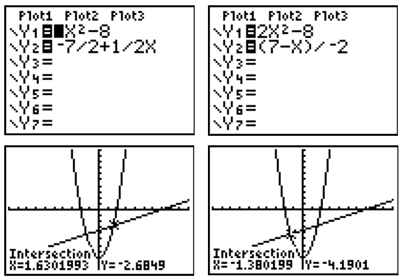
Let’s follow the same procedures outlined above to solve a system that contains an equation that is non-linear. There can possibly be zero, one, or two points of intersection.
Example: Solve by graphing 
Solution: The second equation is the same as in the last example, so we already know that y = (7 − x) − 2 or y = – 7 2 + 1 2 x − either one will do.

Because there are two points of intersection, the intersect feature must be used twice. Be sure that you move the cursor near each point of intersection first. As you can see by these coordinates, without the help of the graphing calculator we could only estimate where the solutions would occur.
The approximate solutions are (1.53, -2.68) and (-1.38, -4.19).
If you feel you need additional practice, click here.
Create an entry in your notes comparing and contrasting how to solve systems of equations using tables and using graphing. Be sure to discuss how graphing calculators are used.
Write another entry comparing and contrasting the solving of a system involving a non-linear equation and the solving of a linear system.
Write a third entry to discuss whether or not you found the APPLET helpful in understanding the relationship between situations, equations for the systems, graphs, and solutions. Justify your opinion with constructive criticism or praise.